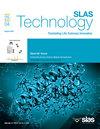Biomechanics-based Gradient Nano-surface Implants Screening and Its Adoption in Dental Implant Repair
IF 3.7
4区 医学
Q3 BIOCHEMICAL RESEARCH METHODS
引用次数: 0
Abstract
Background
this study aimed to screen the micro/nano surface of pure titanium implant gradient for performance analysis, and to explore its role in dental implant repair.
Methods
after treatment with different concentrations of hydrofluoric acid and varying etching times, titanium plates with micro/nano gradient surfaces were selected and divided into four groups: polished, b, c, and d. The microscopic morphology of the titanium surfaces was observed, and the contact angle was measured. One implant was inserted into the femoral metaphysis on both sides of 28 SD rats. Histological sections were analyzed, and the maximum pull-out force was measured.
Results
the new bone trabeculae on the surfaces of groups b, c, and d were wider as against polished group. The surface morphology of the titanium disks etched with 1.2 % hydrofluoric acid for 15 min (group d) was more uniform, the diameter of micropores was the largest, and the contact angle was the smallest (12.1 ± 1.17°). The new bone structure on the surface of implant screws in group d was slightly higher as against groups b and c. The bone-to-implant contact (BIC) and the maximum pullout force in groups b (33.25±2.57 %, 58.52±4.03 N), c (35.16±2.35 %, 59.43±3.97 N), d (40.93±2.71 %, 68.22±4.36 N) were higher as against polished group (22.41±2.86 %, 30.12±4.71 N) (P < 0.05). Three months after implantation, the bone fusion rate in the other three groups was significantly higher than that in the polishing group, with group d showing higher rates compared to groups b and c (P < 0.05).
Conclusion
the gradient micro/nano surface was constructed by hydrofluoric acid. The osseointegration of hydrofluoric acid etching implant surface and implant was clearly better as against polished group.
基于生物力学的梯度纳米表面种植体筛选及其在种植体修复中的应用
本研究旨在筛选纯钛种植体梯度的微纳表面进行性能分析,并探讨其在种植体修复中的作用。方法选择具有微纳梯度表面的钛板,经过不同浓度的氢氟酸处理和不同的蚀刻次数,分为抛光、b、c、d四组,观察钛表面的微观形貌,并测量接触角。在28只SD大鼠的两侧股骨干骺端植入一枚假体。对组织切片进行分析,并测量最大拔出力。结果b、c、d组表面新生骨小梁较抛光组更宽。经1.2%氢氟酸蚀刻15 min (d组)的钛片表面形貌较为均匀,微孔直径最大,接触角最小(12.1±1.17°)。d组种植体螺钉表面新骨结构略高于b、c组,b组种植体与骨接触(BIC)、最大拔牙力(BIC)(33.25±2.57%,58.52±4.03 N)、c组(35.16±2.35%,59.43±3.97 N)、d组(40.93±2.71%,68.22±4.36 N)均高于抛光组(22.41±2.86%,30.12±4.71 N) (P <;0.05)。种植3个月后,其余3组的骨融合率均显著高于抛光组,其中d组高于b组和c组(P <;0.05)。结论用氢氟酸构筑了梯度微纳表面。氢氟酸腐蚀组种植体表面与种植体的骨整合明显优于抛光组。
本文章由计算机程序翻译,如有差异,请以英文原文为准。
求助全文
约1分钟内获得全文
求助全文
来源期刊

SLAS Technology
Computer Science-Computer Science Applications
CiteScore
6.30
自引率
7.40%
发文量
47
审稿时长
106 days
期刊介绍:
SLAS Technology emphasizes scientific and technical advances that enable and improve life sciences research and development; drug-delivery; diagnostics; biomedical and molecular imaging; and personalized and precision medicine. This includes high-throughput and other laboratory automation technologies; micro/nanotechnologies; analytical, separation and quantitative techniques; synthetic chemistry and biology; informatics (data analysis, statistics, bio, genomic and chemoinformatics); and more.
 求助内容:
求助内容: 应助结果提醒方式:
应助结果提醒方式:


